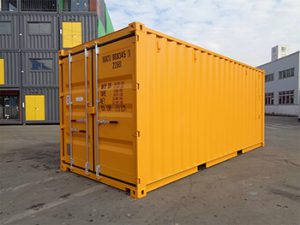Containers are one of the most important units of international transportation that are designed and built according to the characteristics and conditions of commercial shipments. Choosing the right container according to the desired type of goods is very important in the process of transfer and safety of goods. In the following, we will explain more about 10 types of containers so that you can choose the best one according to your product.
Types of containers
-
General purpose container (also known as dry container)
Dry storage containers are the most common containers used in the shipping industry. These shipping containers are fully enclosed and protect the goods and air inside the container. Dry storage containers are used to transport dry goods and are not allowed to transport food or chemicals. One of the reasons for this is the inability to control the temperature. There are about seventeen million intermediate containers in the world, and the bulk of the world’s international shipping through international trade، is transported by these shipping containers. The use of these containers has reduced the cost of transportation of goods and increased long-distance trade. They come in lengths of 20, 40 and 45 feet.

-
Flat rack container
A flat shelf container has no roof and has only two sides. This makes the container ready to carry heavy loads. this type of container is suitable for transporting large and heavy goods such as heavy machines, vehicles on tracks and construction materials. Some flat rack containers are retractable, and some have additional walls that can be attached to the frame. Most flat rack containers are 20 or 40 feet long and are made of steel for strength and durability.
-
Open top container
This type of container is basically a Dry Storage type but with a convertible top that can be completely removed so that materials of any height can be shipped easily. These containers have a plastic roof that can protect loads in times of rain. They are also available in 20 or 40 feet long.
-
Double door container
They are a kind of storage unit that is provided with double doors, making a wider room for loading and unloading of materials like construction materials include steel, iron etc. this container is available in standardized sizes of 20ft and 40ft.
-
Tunnel container
Container storage units are provided with doors on both ends of the container, they are extremely helpful in quick loading and unloading of materials.
-
High cube container (HC)
High cube shipping containers are similar in structure to dry storage containers, but taller. These containers are used in cases where a bigger volume capacity is required.
-
Open side container
This type of container is the best type for goods that are difficult to be loaded or moved within the tunnel container or dry storage container because it has one long side that can completely open and makes it easier to move the cargo inside the container.
-
ISO Reefer container
Refrigerated containers are the best containers for transporting temperature-sensitive goods. Goods such as perishable produce, medicines, chemicals. This container type relies on external power to keep the temperature regulated. When being transported over the road on a trailer or over rail wagon, they can be powered from diesel powered generators which attach to the container whilst on road journeys. Refrigerated containers are capable of controlling temperature ranging from -65 °C up to 40 °C. the temperature inside the reefer is always under control with the help of a device called thermograph.
-
Half-height container
these containers are half the height of full-sized containers. Used especially for goods like coal, stones etc. which need easy loading and unloading.
-
ISO tank container
Tanks are storage containers designed to hold liquids. They are usually constructed out of anti-corrosive materials because of the chemicals they are used to carry.
FCL (full container load):
This means that you fill the full capacity of one container to carry your goods. If you are looking to import or export a large amount of goods, FCL (full container load) may be a more suitable method for you. All you need to do is determine the size of the container capacity you need.
LCL (less than container load):
Instead of filling the container with your own goods, you share this space with other importers or exporters. These containers are basically filled with goods that are related to several customs licenses. Goods with a volume less than one container that correspond to different buyers who jointly fit together in one container.